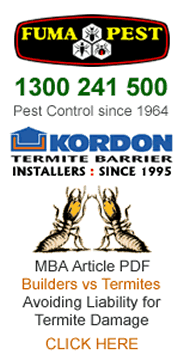Coptotermes acinaciformis - common in Rockdale Sydney Metro Region particularly in built-up urban areas - under concrete on-ground flooring - areas where eucalypt gum trees are prevalent.
Highly Destructive - most widely distributed and destructive timber pest in the region - accounts for more than 70% of damage to buildings - a single colony may contain more than 1 million termites.
Nest Location - Coptotermes acinaciformis - very secretive termite species - build their nest out of sight, often within the base of eucalyptus or other susceptible trees, or completely under the ground - often within an enclosed patio or under concrete on ground flooring which is ideal for moisture retention, temperature and humidity control within the termite colony's central nest. |
Schedorhinotermes intermedius - often found in Rockdale Sydney Metro Region - they appear to gouge affected timber - soldiers contain a larger major 6mm length - minor soldier 4mm length.
Destructive Nature - Schedorhinotermes intermedius are highly destructive to buildings and other timber structures. If mostly major (larger) soldiers are sighted, it is most likely a large colony with the potential to cause severe and rapid damage to structural timbers of a building and timber structures.
Nest Location - Schedorhinotermes intermedius commonly build their nest in tree stumps, in the root crown of living, dead or debilitated trees, under houses or within enclosed patios or other areas where timber is buried or stored in contact with the soil. |
Coptotermes frenchi - are found in the Rockdale Sydney Metro Region - particularly in built-up urban areas, where homes and buildings are constructed of softwood or oregon timber framing.
Highly Destructive - causing severe damage to buildings and other wooden structures - often devouring timber framing leaving behind only a hollowed out thin veneer.
Nest Location - Identification - they often build their nest in root crown or lower trunk area of living trees, particularly eucalypts - may build their nest as a mound in dryer areas - Coptotermes frenchi is an extremely shy termite - they will retreat from a location immediately, if disturbed.- the soldiers have a pear shaped head compared to a somewhat rectangular head of Coptotermes acinaciformis. |
Nasutitermes exitiosus are commonly found in the Rockdale Sydney Metro Region and other areas of NSW - particularly in built-up urban areas or where eucalypt gum trees are highly prevalent.
Destructive Nature - Nasutitermes exitiosus are destructive to buildings and other timber structures. Sometimes severe damage may occur, but not so commonly as the other species listed above.
Nest Location - Nasutitermes exitiosus build a mound nest which protrudes 30cm to 75cm above ground. The observed nest can be treated with Termidor Termiticide for total colony elimination. |
Coptotermes lacteus are found in the Rockdale Sydney Metro Region and accross eastern NSW - particularly prevalent along the entire coast-line, along the Great Dividing Range and western slopes.
Destructive Nature - Coptotermes lacteus attacks stumps, dead trees, timber fences, poles and other timber structures that are in contact with the soil, being softened by weathering or decay. These termites are also known to attack such timber in damp sub-floor areas.
Nest Location - this termite species, most often builds it's nest as a mound up to 2m above ground level, with hard clay walls - to eradicate the colony - treat with Termidor Termiticide. |
Nasutitermes walkeri are commonly found in the Rockdale Sydney Metro Region and other coastal and mountain regions along the eastern side of NSW.
Nasutitermes walkeri can be destructive to damp timbers often a serious problem where the sub-floor of a building is damp and ventilation is poor with resulting wood decay or fungal growth.
Nest Location - Nasutitermes walkeri build a nest in trees on the main trunk or in fork of large branch. |
Heterotermes ferox are commonly found in the Rockdale Sydney Metro Region particularly where eucalypt gum trees and damp decaying timber are highly prevalent.
Prefers Damp Decaying Timbers - usually encountered attacking posts, poles, paling fences, timber decking and flooring - wherever weathering and decay are present - sometimes may cause severe damage to sound timbers - often confused with the more destructive Coptotermes acinaciformis.
Nest Location & Identification - a multi-nester - small subterranean nests - near stumps, rotting wood or nests of other species - do not range far from nest - do not have extensive gallery systems - leave affected timber with mottled appearance - soldiers 3.5 to 7.5mm - with a long rectangular head - no obvious teeth on dark mandibles - display a peculiar shuffle backwards when confronted. |
Dampwood Termites form small independent nests which often attack sick or dead trees, decaying stumps or mould timber in the ground; they are seldom found in dry timbers in buildings. |
Drywood Termites occur mostly in tropical areas, where atmospheric humidity is constantly above 75 percent. The introduced and highly destructive West Indian drywood termite, Cryptotermes brevis, is rarely located in NSW, once in Sydney in the early 1980's. Specialist eradication procedures involve wrapping entire building in plastic and using methyl bromide fumigation. |
